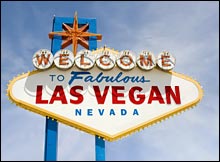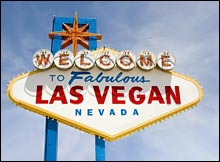Quick: Where can you eat vegan doughnuts for breakfast, vegetarian Chinese for lunch, and 13-bean soup for an afternoon snack? Hint: In the same city, you can feast on sustainable fish for dinner, prepared by one of the country’s celebrity chefs, and Kind Apple Cobbler for dessert — the “raw” version.
New York? Maybe. Seattle? Probably. Las Vegas? Definitely.
Surprised? The locals aren’t.

Green? You bet your life.
All-night buffets and free cocktails are Vegas’ usual claim to culinary fame, but their notoriety has overshadowed long-established, healthier outposts: a pick-your-own orchard, a natural-foods store, a vegan doughnut shop. Now a quietly growing movement is offering residents and visitors even more health- and earth-friendly options.
From vegan desserts to sustainable seafood, Sin City is polishing its palate. And with more than 1.8 million residents living in Clark County and 38.5 million tourists descending each year, there are plenty of mouths to feed. But like everything in Vegas, all this goodness comes with a price.
Last New Year’s Eve, Wolfgang Puck’s Spago restaurant in Caesar’s Palace — smack-dab in the middle of the legendary Strip, where the neon is unrelenting and energy consumption ceaseless — unveiled an all-organic holiday menu. Its 10 appetizers and 10 entrees featured offerings like grilled salmon with lobster risotto and sautéed spinach, crisp free-range chicken with creamy garlic potatoes and baby squash, and roasted quail with green lentils and braised rainbow chard. Plans are in motion to make Spago’s organic tryst permanent later this year, but the restaurant is encountering roadblocks along the way.
Spago normally buys 15 dozen eggs for $40, but when chefs asked their supplier for an organic alternative, they were quoted a price of $200 — for eggs flown in from New Zealand. And there’s the rub, at least for those who are trying to eat healthy and be environmentally sensitive. At what point does organic produce or sustainable seafood become unsustainable? In other words, how green can you be in the middle of the desert?
Mirage Sale
In Vegas today, nearly all food needs to be shipped in, traveling hundreds or sometimes thousands of miles. But it wasn’t always so. Prehistorically, southern Nevada was a marsh of abundant water and vegetation. Las Vegas is Spanish for “the meadows,” and the area supported edible fruits and vegetables including Indian rye grass, once a staple for local indigenous people. In the 19th century, food and supplies were commonly brought in by boats that powered along the Colorado River.
Those were the days.
Today, cargo holds of trucks and planes are loaded with meat, seafood, and produce from all parts of the world to accommodate Vegas’ seemingly insatiable appetite for the newest new thing and the finest fine dining. It’s difficult to nail down exactly how many pounds of produce are flown into Vegas daily; McCarran Airport requires airlines to report only the total weight of their freight, not itemized cargo. But the numbers are decidedly hefty: sources estimate, for instance, that 60,000 pounds of shrimp are consumed in Las Vegas every single day.

Desert cherries require no irrigation
and thrive on secondhand smoke.
Photo: iStockphoto.
So, like anyone who thinks about where their food comes from, chefs in Vegas face a tangle of choices. Rick Moonen of rm seafood at Mandalay Bay — who became active years ago in efforts to support environmentally safe seafood for his restaurant in New York City — knows the conundrum well. “We believe in the importance of buying and serving seafood which comes from abundant wild populations and are under sound management,” his menu boasts. “All fish on our menu are caught or farmed in a way that is not harmful to the ocean environment or to other ocean creatures. We are strong supporters of local fishing communities, and take responsibility for our role in preserving a lasting and diverse supply of seafood.”
But local fishing communities don’t exactly pepper Las Vegas. So Moonen casts a wider net, performing both taste tests and eco-research before allowing a fish on his menu. One fish that’s made it through his hoops is barramundi. The hatcheries are in Australia (“I know, I know! Australia,” he says); the fingerlings are flown (“I know, I know! Flown … “) to Massachusetts, where they grow to maturity. What’s appealing to Moonen about this particular species is that it’s part of a closed loop, with effluent recycled back into the ecosystem as fertilizer.
Moonen doesn’t pretend that he’s created the perfect eco-menu — he pleads the Fifth when asked why foie gras is still an offering — but feels it’s important to at least take steps in the right direction. “You can water down [environmental] efforts until nothing gets felt,” he says, “until nothing gets done.”
Luck a l’Orange
So can this town have an impact on the market for sustainably produced food, even with its geographical handicap? With tourists spending about $250 on meals during a typical three- to four-day stay, odds are a hundred to one it can.
In April, Whole Foods — which has recently committed to upping its support of local farmers — opened a second store in a residential neighborhood across town from the first. Having two Whole Foods stores puts Vegas on par, in that category, with cities like San Francisco, Austin, Boston, Philadelphia, and Baltimore. Add to that an already existing network of natural-food and vegetarian restaurants, and things are looking up.
Most of the city’s green-dining establishments are “off-Strip,” springing up in neighborhoods that, given Vegas’ unprecedented growth in the past few years, are increasingly diverse and ethnically vibrant. Paul Hartgen, president of the Nevada Restaurant Association, says chefs and owners at these smaller locations focus on creating food that’s as authentic as possible — and in the case of many Asian cultures, “authentic” means “vegetarian.” Last year, for example, Iris Lee opened Veggie Delight in Vegas’ Chinatown, with a menu that features both vegan and vegetarian options from the traditional cuisine of Vietnam, where she was born, and Taiwan, where she was raised. Lee says she wanted to offer something “convenient for vegetarians, because most of the time they couldn’t find a place to sit down and eat.”
Unless they were in the mood for doughnuts, that is. Since Ronald’s Donuts opened nearly 14 years ago, it’s been quietly offering vegan varieties of its treats. No sign advertises the option, but even without the hype, word’s gotten around: owner Henry Kang says he and his family enjoy a loyal customer base of vegan-oriented locals, as well as tourists from cities like Los Angeles, San Diego, and Salt Lake. As for the doughnuts, they look and taste like the regular variety — only better. The glazed concoctions are two very airy inches high, with a crispy, sweet crust that starts melting as soon as it hits your fingers.
Kang isn’t the only natural-food veteran in this town. A few miles away sits Rainbow’s End Natural Foods & Café, which opened its doors more than 30 years ago. The café has changed hands over the years — Sam Freedman took ownership just six months ago — but it has always been the place to go for whole foods, vitamins, and supplements, including a homeopathic allergy mix made for the Las Vegas climate. Rainbow’s End shares a history — and some of its business — with Gilcrease Orchard, which began as a ranch 86 years ago in the northwestern part of the city. It’s the only orchard within 200 miles, and still opens its fields for pick-your-own apples, peaches, melons, tomatoes, zucchini, and other produce throughout the seasons. Rainbow’s End stocks its shelves with gallons of Gilcrease’s apple cider, and Gilcrease’s sends interested consumers to Rainbow’s End during the off-season.
It’s that kind of community that inspires the owners of a “living cuisine” restaurant and juice bar, Go Raw Café, whose two locations in the Vegas valley opened three years ago. Whether or not the sustainable-food movement catches on in a big way in the city of high rollers, they’ll keep turning out meals sure to please discerning diners. “You don’t open a restaurant like this because of your strong motivation for success,” says co-owner Lu Vuckovich. “You open this type of restaurant to help your fellow brothers and sisters. Success is a bonus side effect.”


